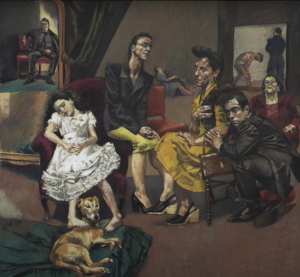What an extraordinary body of work Dame Paula Rego (26 January 1935 – 8 June 2022) created throughout her life! Never one to get complacent, each chapter of her life, each crisis, provided material for a new series of paintings.
Born in Portugal in 1935, Rego was drawing from when she was a child. Her father felt if she was to succeed, she needed to leave her country of birth with its right-wing regime and so she headed for the Slade School of Art in London in 1952. There she met her future husband Victor Willing.
After moving back to Portugal, the dictatorship provided fodder for a burst of new work from Rego in which she broke away from the style of work she’d done at the Slade. In 1966, her husband Vic was diagnosed with multiple sclerosis and the darkness of these days is revealed in Rego’s work of the time. They eventually moved back to London permanently after 1974.
It wasn’t until 1994 that Paula Rego began using pastels as her primary medium.
From doing work that emerged from her mind and imagination, Rego turned to drawing from life and this was when she started using pastels. From the story of a woman who hears a voice in the wind encouraging her to eat her pets, emerged a series that show women doing dog-like things like waiting for food, growling, and grooming.
The first in the series, “Dog Woman,” shows a bestial, growling woman on all fours. As a viewer, you’re bowled over both by the primal nature of the content and the lush, expressive application of pastel. All the women in the series appear downtrodden yet powerful in their physicality. These large and disturbing figurative paintings launched a new era in Rego’s work and, for pastellists, raised up the medium to take its place as a legitimate and accepted medium for contemporary work.
Rego continued to work in pastel throughout the remainder of her life creating monumental and disturbing works like the Father Amaro series inspired by the 19th century novel by José Maria de Eça de Querioz and the Betrothal triptych from 1999 after Hogarth’s Marriage A-la-Mode. And then there are the abortion series from 1998 and The Pillowman from 2004 which is based on the play by Martin McDonagh.
In all these works, a combination of beauty and discomfort co-exist. We, the viewer, may be seduced by the accessible scene as well as the sensuous and robust application of pastel while at the same time, we’re unsettled and squirmy looking at the content. But it’s that disturbing narrative that reveals Rego’s immense courage.
Rego liked to start her pieces with hard pastel. In a video interview she said, “I preferred the really hard ones, because they gave you resistance, so you could actually push, and… and scratch with them, which was very nice, and… and draw, and… and then you’d… you’d use the softer ones for later, for the top layer or something like that. So I began… I did one, I did the first ‘Dog Women’, and then I did the second Dog Women, which is ‘Waiting for Food.’
I hope this wee taste whets your appetite and encourages you to go explore this artist’s incredible work. It’s on my bucket list to see her work in the real!
Let me know in the comments on the website what your take is! My hope is, even if you don’t like her work (and please examine why), that you’ll appreciate the place she holds in the pantheon of great artists.
Gail
_________________________________________________________
Let’s Start You Down The Paula Rego Rabbithole!
I wasn’t sure what I’d write about for this piece as there’s so much being shared right now on the internet about this renowned artist. Just google her and it’s easy to go down the rabbit hole!
Here’s a video to get you started. It was done for the 2021 Tate Retrospective on Paula Rego’s work. Click HERE to watch it.





wow what a powerful and skilled artist. thank you for sharing the excellent video
Thank you for writing about this artist.
I admire her commitment to timely, yet uncomfortable subjects.
The fact that she used pastel as her vehicle for expression is poignant.
Brava Paula, brava Gail!
Thanks Christine!! I’m so glad to find another fan 😁
Thank you, Gail, for introducing me to this amazing artist! I’ve never heard of her before. Yes, her work is a little bizarre but her application of pastel is stunning. I’ll be studying her work in more depth. If this is a sign of the gems we can expect in your posts, I’m all in!
I’m delighted to have introduced you to this amazing artist Francesca! I too am deeply into studying her work…again!
Thanks for sharing the work of this remarkable artist. Her work is so rich and, yes, uncomfortable. (Great art is not just pretty!) The comparisons to Goya are particularly apt, I think.
You are so welcome Judith. I’m glad you appreciate Rego’s extraordinary (if disturbing) work!
Hello Gail, thank you so very much for introducing us to Dame Paula Rego. Thank you for your pastel site in general. Brava.
I’m always delighted to introduce the magnificent artist who was Dame Paula Rego.
And thank you Shelley!!